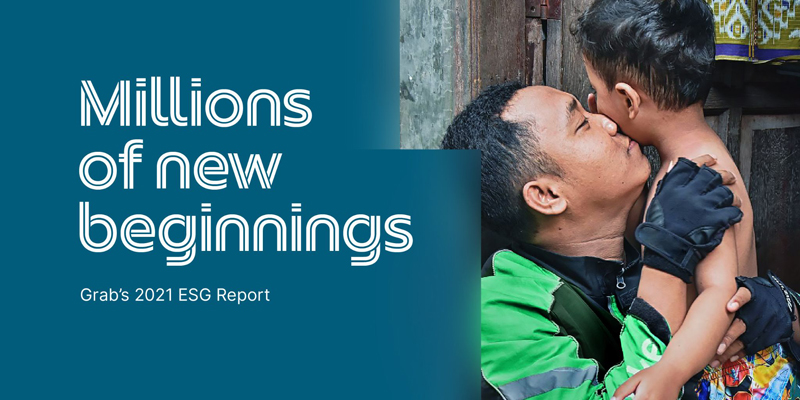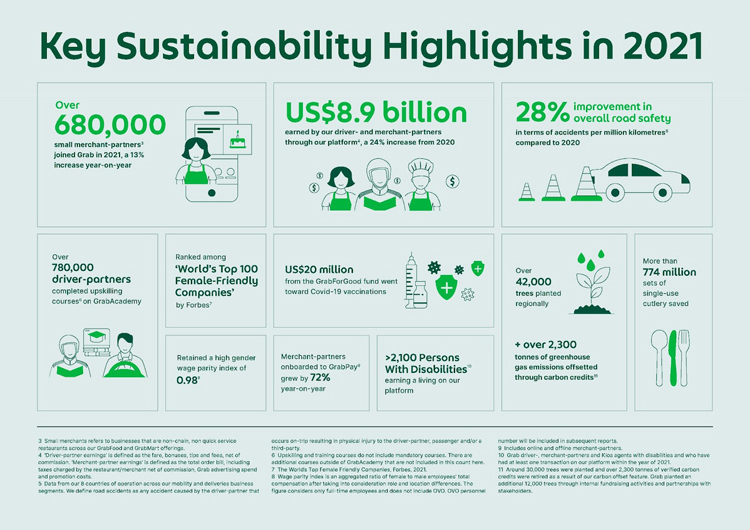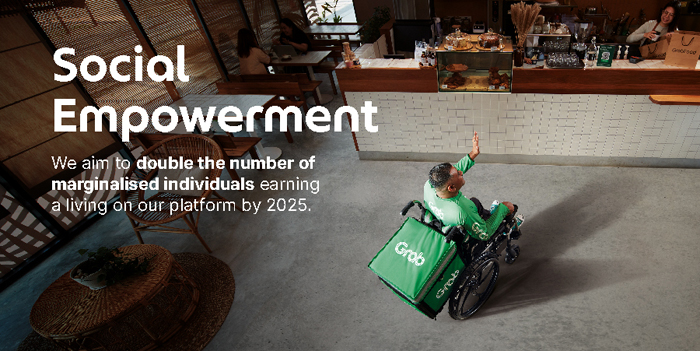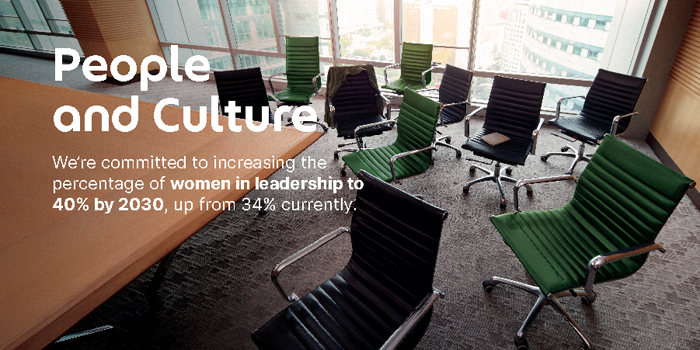- Commits to doubling the number of marginalised individuals earning an income on its platform by 2025, achieving 40% female leadership by 2030 and becoming carbon neutral by 2040
- Rolls out new programme, Grab Access, to make the platform more accessible for marginalised individuals
- Consumers can view their personal impact report on the Grab app from 17 May
MANILA PHILIPPINES, May 18, 2022 – Grab, Southeast Asia’s leading superapp, today announced three goals to drive sustainable and inclusive growth in Southeast Asia. The new goals are: 1) doubling the number of marginalised individuals earning income on its platform by 2025, 2) reaching 40% female leadership by 2030, and 3) achieving carbon neutrality by 2040. These goals were unveiled in the company’s annual Environment, Social and Governance (ESG) report released today.
“We have to confront two important realities in a rapidly growing digital economy. First, an unequal access to opportunities, and second, an acceleration of climate change. This is why we are focusing our ESG goals on driving inclusive growth and closely managing the environmental footprint of our ecosystem. Our journey to becoming a triple bottom line company reflects our strong belief that the long-term success of our business is intricately linked to the welfare of the communities we serve, and the health of our planet,” Anthony Tan, Co-Founder and Group Chief Executive Officer, Grab.
“Our ESG goals are vivid expressions of Grab Philippines’ deep and long-lasting commitment to the Filipino people, and we will continue to leverage our technology and expertise to help build safer, stronger, and more prosperous digital-first communities in the Philippines that everyday Filipinos can be truly proud of. Through the ESG Goals, we will strengthen our ongoing commitment to providing our kababayans access to meaningful livelihood opportunities on the platform, help Filipino talents become more digitally ready and competitive, and play our part in reducing our carbon footprint. We are optimistic that through our collective efforts – alongside our partners and the government, we can help uplift the lives of many Filipinos for the years to come,” Grace Vera Cruz, Country Head, Grab Philippines.
Grab’s ESG report also tracked the company’s impact in 2021 across key priority areas:
- Grab continues to facilitate economic growth and uplift communities, bringing over 680,000 small merchant-partners onto the platform, and upskilling over 780,000 driver-partners through GrabAcademy. In 2021, Grab’s partners earned US$8.9 billion on the platform, a 24% increase from 2020. The company also contributed US$20 million from the GrabForGood fund to provide free Covid-19 vaccinations for partners.
- Ensuring the safety of Grab’s partners and consumers remains a top priority for Grab. On-demand deliveries boomed at the height of the pandemic. However, the industry also saw an increase in road traffic accidents during this period of time. Through additional safety measures and training, Grab’s accident rate for its delivery segment improved by 36% year-on-year, even against strong growth in its delivery business. In 2021, more than 99.99% of Grab’s rides occurred without any incident.
- Grab is committed to reducing greenhouse gas emissions and plastic waste. In 2021, Grab switched to powering all its corporate offices with 100% renewable energy, and launched a 100% low-emissions 2-wheel rental fleet in Indonesia.
Grab’s carbon offset and cutlery toggle features enabled users to make greener choices in everyday decisions. The features contributed to the planting of over 42,000 trees regionally, offsetted more than 2,300 tonnes of greenhouse gas emissions through carbon credits, and reduced the use of more than 774 million sets of single-use cutlery.
New commitments as a triple bottom line company
Grab continues to invest in Southeast Asia. Its latest ESG goals ensure the company’s growth and success have a positive impact on the communities it operates in:
- Driving digital inclusion for marginalised groups
According to the World Bank, one billion people, or 15% of the world’s population, experience some form of disability. The UN Economic and Social Commission for Asia and the Pacific estimates that persons with disabilities (PWD) are two to six times less likely to be employed as compared to persons without disabilities.
Commenting on this, Marlon Fuentes, a PWD driver-partner from the Philippines who has Tourette’s syndrome, said: “Being a driver-partner for Grab allows me to provide for my family, while also spreading awareness about Tourette’s Syndrome. Through Grab’s support, not only was I able to drive and earn, I also got the chance to inspire people—regardless of their physical capabilities—to keep living their lives to the fullest.”
In a regional survey of driver-partners with disabilities, 73% reported that they maintained or increased their earnings by working with Grab. 80% of PWD driver-partners said they felt fulfilled and satisfied with life by working with Grab. Yet, only 2,100 PWDs earn an income on the Grab platform today.
Grab seeks to double the number of marginalised individuals who earn a living through its platform by 2025. To enable this, Grab plans to launch Grab Access, a regional programme to lower the barriers for marginalised individuals to join Grab. The programme will provide these individuals with special financial and training support for a period of time to help them adapt and ease into the platform. Grab Access will roll out first in Indonesia, with other countries to follow this year.
- Supporting females to grow in the workplace
Grab is committed to working towards increasing the percentage of women on its leadership bench to 40% by 2030, up from 34% currently. This ensures the company has diverse voices in management positions and considers a variety of views in crafting and implementing policies and decisions.
The company will continue to invest in mentorship and leadership programmes to support career development for female employees; create more comprehensive support networks for females in the workforce; invest in proactive measures such as data-driven studies and training programmes to help managers catch and address any unconscious biases that may occur in candidate interviews and performance review processes.
Grab continues to maintain a high gender wage parity, with female employees earning 98 cents to a dollar paid to male employees for performing a similar role at Grab.
- Managing its environmental impact
Grab is committed to actively manage its carbon footprint, with the goal to become carbon neutral by 2040 even as the business continues to grow significantly over the years. It will focus first on implementing measures to reduce emissions before turning to offsets.
As a platform that facilitates on-demand mobility and deliveries, 96% of Grab’s total emissions in 2021 came from vehicles owned and operated by its drivers and delivery-partners. Hence, a core part of Grab’s strategy is to help build an inclusive EV ecosystem that caters to the middle and middle-lower class.
To this end, Grab works with governments, charging infrastructure providers, and automakers across Southeast Asia to conduct EV pilot studies and research; plan and develop EV charging infrastructure and battery swapping stations; financing products to support greater EV adoption, and more. Today, Grab operates the largest ride-hailing EV fleet in Indonesia, comprising around 8,500 electric vehicles.
To reach carbon neutrality by 2040, Grab will:
- Continue to drive the transition to low emission vehicles among its partners, including transitioning 100% of its ride-hailing fleet in Singapore to low emission vehicles by 2030.
- Achieve net zero operational carbon for all premises as a member of EP100, by transitioning all other premises operated by Grab and under its direct control such as data centres and operation hubs to renewable energy by 2030.
- Continue to develop artificial intelligence and machine learning to further optimise for resource efficiency across all areas of its business and operations, such as order batching and ride-sharing to reduce unnecessary travel.
- Work with suppliers and vendors within our value chain to minimise emissions.
- Invest in high quality carbon offsets in Southeast Asia and explore carbon capture solutions.
- Educate and empower consumers to manage their environmental footprint by opting for mobility options with lower emissions or carbon offsets.
To read more about Grab’s ESG report, visit the link here.
Grab users can check out their personal impact report in the Grab app from 17 May.
Liked this post? Follow SwirlingOverCoffee on Facebook, YouTube, and Instagram.






